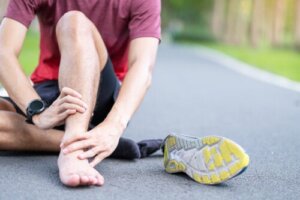Achilles Tendon Rupture: Causes, Treatment and Rehabilitation


Reviewed and approved by the doctor Diego Pereira
An Achilles tendon rupture is an injury of the fibrous cord that connects the muscles at the back of the calf with the heel bone. It’s common in people who practice sports activities, although it’s also associated with being overweight and taking certain medications.
It occurs when the tendon suffers a partial or total tear due to stretching that exceeds its capacity. Often, this situation is the consequence of a forced jump, sudden accelerations when running, or too much pressure. It can also be caused by a fall or any trauma to the area.
Its main symptoms include pain and inability to walk; these can vary in intensity depending on the severity of the injury. However, most of the time it can be treated with physical therapy and exercises. Do you want to know more about it? Find out more about its causes and about the rehabilitation process.
What are the causes of an Achilles tendon rupture?
The Achilles tendon is a band of tissue that runs across the back of the lower leg. It’s responsible for attaching the gastrocnemius and soleus muscles to the calcaneal bone. This band, which is also known as the ‘heel cord’, propels the foot off the ground and allows you to walk, run, or jump.
In most cases, the rupture occurs at the point of the tendon that is located about 6 centimeters (just over 2 inches) from where it attaches to the heel bone. It’s most likely to occur when the leg is extended and the calf muscle is contracted.
Find out more: Diego Carlos: His Musculature and a Serious Achilles Tendon Injury
Risk factors

As detailed in a publication in the Journal of Functional Morphology and Kinesiology, Achilles tendon rupture occurs more frequently during sports. Middle-aged men – especially untrained athletes – are more at risk compared to younger men.
Other risk factors identified include the following:
- A sudden increase in the pressure exerted on the Achilles heel
- Regular practice of sports that involve jumping
- Trips, falls, or accidents
- Treatment with steroid injections
- Prolonged consumption of antibiotic medications
- Anatomical deviations
- Excess weight and obesity
- Chronic inflammation or rheumatoid arthritis
Symptoms of the rupture of the Achilles tendon
On occasions, the rupture of the Achilles tendon heals itself asymptomatically. However, due to its severity or lack of treatment, it can cause the following clinical manifestations:
- The sensation of having received a blow to the calf
- The inability to bend the foot or stand on tiptoe
- Abnormal gait
- Inability to propel the injured leg forward when walking
- Hearing a snap or crackle when the injury occurs
- Difficulty climbing stairs
- Bruising or swelling in the leg or foot
Diagnosis
To make a diagnosis of an Achilles tendon rupture, the physician will begin with a physical examination of the affected area. First, he or she will inspect the calf for signs of tenderness or swelling. At this point, you may feel a space if the tendon is completely ruptured.
In the next step, the practitioner will ask the patient to perform a series of movements and exercises to determine range of motion and muscle strength. If the Achilles tendon is ruptured, the person will have less ability to push down or lean on the toes.
Additional diagnostic tests may include ultrasound or MRI. These procedures are painless and are meant to create images of the body’s tissues to learn the exact extent of the injury.
Read more here: 24 Common Injuries in Dancers
Achilles tendon rupture treatment
To design an appropriate treatment for a ruptured Achilles tendon, the practitioner must consider important factors such as age, lifestyle, and severity of the injury. Sometimes, especially if they’re athletes, people choose surgery to repair the tendon.
However, before resorting to this measure as an alternative, there are some care and habits that support the recovery process with a favorable prognosis. Let’s see it in detail.
Non-surgical treatment
Non-surgical treatment of Achilles tendon rupture avoids risks associated with surgery, such as infection. However, its disadvantage is that recovery may take longer and the injury may recur. These measures include the following:
- Use of crutches. This is a measure suggested by the orthopedic physical therapist to keep the tendon at rest.
- Placing ice on the affected area. The application of ice compresses for 15 to 20 minutes, every 4 to 6 hours, helps to reduce pain and inflammation.
- Take over-the-counter analgesics and anti-inflammatory drugs. These help control pain and swelling.
- Keep the ankle at rest for the first few weeks.
- Do recovery exercises guided by a physical therapist.
Surgical intervention

Surgery to repair the Achilles tendon is a procedure that involves an incision in the lower leg. Through this, the torn tendon is reattached by means of stitches.
Now, as detailed in a study shared through Frontiers in Surgery, surgical treatment decreases the rate of re-rupture, but has a higher rate of complications compared to conservative treatment.
Rehabilitation
The rehabilitation process of an Achilles tendon rupture includes a series of physical therapy exercises that aim to strengthen the muscles of the leg and, of course, the tendon. Most of the time there’s a full recovery in a period of 4 to 6 months.
It’s very important to comply with this plan hand in hand with a professional, as the exercises should be implemented gradually. That’s to say, their level of intensity will change as the recovery phase progresses.
On the other hand, there’s a type of rehabilitation known as ‘functional rehabilitation‘. This consists of performing some weight-bearing exercises, focused on the ankle, which are usually done in the first few weeks after the injury. In fact, they’re put into practice while the person is still wearing their immobilization device.
A review of studies shared by Foot and Ankle Clinics reported that these types of therapies can offer similar results to surgical treatment. Of course, it must be done in the hands of a physical therapy professional. The idea is to recover mobility and physical performance.
Once the recovery process is completed, the risk of having a new trauma increases. Therefore, it’s important to take preventive measures such as the following:
- Keep in good shape and do warm-up and stretching exercises before any sports practice.
- Avoid high heels or shoes that are inappropriate for sports.
- Ask your doctor if you can play tennis, basketball, and other sports.
- Maintain a healthy diet.
- Avoid being overweight.
What to remember:
An Achilles tendon rupture can cause pain and limited movement. Although it most often affects athletes, anyone can suffer from it, whether due to an accident, improper sports practice, or being overweight.
In many cases, it improves after a period of rest and physiotherapy. However, surgery is sometimes required. Therefore, if there’s any suspicion it could be this injury, it’s best to go to the doctor so that he can guide you and give you the most appropriate treatment according to your individual case.
All cited sources were thoroughly reviewed by our team to ensure their quality, reliability, currency, and validity. The bibliography of this article was considered reliable and of academic or scientific accuracy.
- Aminlari A, Stone J, McKee R, Subramony R, Nadolski A, Tolia V, Hayden SR. Diagnosing Achilles Tendon Rupture with Ultrasound in Patients Treated Surgically: A Systematic Review and Meta-Analysis. J Emerg Med. 2021 Nov;61(5):558-567. doi: 10.1016/j.jemermed.2021.09.008. Epub 2021 Nov 17. PMID: 34801318.
- Egger AC, Berkowitz MJ. Achilles tendon injuries. Curr Rev Musculoskelet Med. 2017 Mar;10(1):72-80. doi: 10.1007/s12178-017-9386-7. PMID: 28194638; PMCID: PMC5344857.
- Glazebrook M, Rubinger D. Functional Rehabilitation for Nonsurgical Treatment of Acute Achilles Tendon Rupture. Foot Ankle Clin. 2019 Sep;24(3):387-398. doi: 10.1016/j.fcl.2019.05.001. Epub 2019 Jun 22. PMID: 31370992.
- Metzl JA, Ahmad CS, Levine WN. The ruptured Achilles tendon: operative and non-operative treatment options. Curr Rev Musculoskelet Med. 2008 Jun;1(2):161-4. doi: 10.1007/s12178-008-9025-4. PMID: 19468891; PMCID: PMC2684209.
- Park SH, Lee HS, Young KW, Seo SG. Treatment of Acute Achilles Tendon Rupture. Clin Orthop Surg. 2020 Mar;12(1):1-8. doi: 10.4055/cios.2020.12.1.1. Epub 2020 Feb 13. PMID: 32117532; PMCID: PMC7031433.
- Shamrock AG, Varacallo M. Achilles Tendon Rupture. [Updated 2023 Mar 19]. In: StatPearls [Internet]. Treasure Island (FL): StatPearls Publishing; 2023 Jan-. Available from: https://www.ncbi.nlm.nih.gov/books/NBK430844/
-
She, G., Teng, Q., Li, J., Zheng, X., Chen, L., & Hou, H. (2021). Comparing Surgical and Conservative Treatment on Achilles Tendon Rupture: A Comprehensive Meta-Analysis of RCTs. In Frontiers in Surgery (Vol. 8). Frontiers Media SA. https://doi.org/10.3389/fsurg.2021.607743
- Tarantino D, Palermi S, Sirico F, Corrado B. Achilles Tendon Rupture: Mechanisms of Injury, Principles of Rehabilitation and Return to Play. J Funct Morphol Kinesiol. 2020 Dec 17;5(4):95. doi: 10.3390/jfmk5040095. PMID: 33467310; PMCID: PMC7804867.
-
Zellers JA, Christensen M, Kjær IL, Rathleff MS, Silbernagel KG. Defining Components of Early Functional Rehabilitation for Acute Achilles Tendon Rupture: A Systematic Review. Orthop J Sports Med. 2019 Nov 25;7(11):2325967119884071. doi: 10.1177/2325967119884071. PMID: 31803789; PMCID: PMC6878623.
This text is provided for informational purposes only and does not replace consultation with a professional. If in doubt, consult your specialist.








